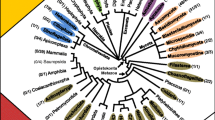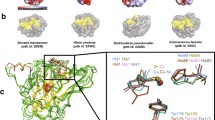Abstract
Cellulose synthase and other members of the family 2 glycosyltransferases are ubiquitous in all kingdoms of life. To date, no attempt has been made to construct a phylogeny that positions cellulose synthases in relation to other members of this family or to elucidate relationships within the cellulose synthase group. In this study, a sequence from the unicellular, marine cyanobacterium Synechococcus sp. PCC 7002 is shown to share a unique common ancestor of a clade consisting of cellulose synthases from Dictyostelium discoideum and Nostoc, as well as a plant grouping that includes CesA proteins and cellulose synthase-like (Csl) proteins G, E, B, D, and F. A branching order is established for Csl proteins that places CslG as ancestral to other members of the Csl/CesA clade. Sequences from Ciona intestinalis and Aspergillis fumigatus are shown to branch at the base of the Eukaryota/Cyanobacteria clade. These data suggest multiple independent transfers of cellulose synthases. The implications of these findings in relation to the evolutionary history of cellulose synthase are discussed.
Similar content being viewed by others
References
Altschul S.F., Gish W., Miller W., Myers E.W.and Lipman D.J.1990.Basic local alignment search tool.J.Mol.Biol. 215:403–410.
Andersson J.and Roger A.2002.A cyanobacterial gene in nonphotosynthetic protists-an early chloroplast acquisition in eukaryotes?Curr.Biol.12:115–119.
Archibald J., Rogers M., Toop M., Ishida K.and Keeling P. 2003.Lateral gene transfer and the evolution of plastid-targeted proteins in the secondary plastid-containing alga Bigelowiella natans. Proc.Natl.Acad.Sci.USA 100: 7678–7683.
Baldauf S.and Doolittle W.1997.Origin and evolution of the slime molds (Mycetazoa).Proc.Natl.Acad.Sci.USA 94: 12007–12012.
Baldauf S., Roger A., Wenk-Siefert I.and Doolittle W.2000.A kingdom-level phylogeny of eukaryotes based on combined protein data.Science 290:972–997.
Bhattacharya D.and Medlin L.1998.Algal phylogeny and the origin of land plants.Plant Physiol.116:9–15.
Bhattacharya D., Weber K., An S.and Berning-Koch W.1998. Actin phylogeny identi es Mesostigma verde as a flagellate ancestor of land plants.J.Mol.Evol.47: 544–550.
Blanton R.L., Fuller D., Iranfar N., Grimson M.J.and Loomis W.F.2000.The cellulose synthase gene of Dictyostelium. Proc.Natl.Acad.Sci.USA 97:2391–2396.
Brocchieri L.2001.Phylogenetic inferences from molecular sequences:review and critic.Theor.Popul.Biol.59:27–47.
Brown R.1985.Cellulose micro bril assembly and orientation: recent developments.J.Cell.Sci.Suppl 2:13–32.
Campbell A.2000.Lateral gene transfer in eukaryotes.Theor. Popul.Biol.57:71–77.
Cavalier-Smith T.2000.Membrane heredity and early chloro-plast evolution.Trends Plant Sci.5:174–182.
Cavalier-Smith T.2002.The neomuran origin of archaebacte-ria,the N negibacterial root of the universal tree and bacte-rial megaclassi cation.Int.J.Syst.Evol.Microbiol.5:7–76.
Cohen M., Wallis J., Campbell E.and Meeks J.1994.Transposon mutagenesis of Nostoc sp.strain ATCC 29133,a filamentous cyanobacterium with multiple cellular differentiation alternatives.Microbiology 140:3233–3240.
Curatti L., Porchia A., Herrera-Estrella L.and Salerno G. 2000.A prokaryotic sucrose synthase gene (susA)isolated from a lamentous nitrogen-xing cyanobacterium encodes a protein similar to those of plants.Planta 211:729–735.
Dehal P., Satou Y., Campbell R.K., Chapman J., Degnan B., De Tomaso A.et al.2002.The draft genome of Ciona intestinalis:insights into chordate and vertebrate origins.Science 298:2157–2167.
Delmer D.1999.Cellulose biosynthesis:exciting times for a diffcult eld of study.Annu.Rev.Plant Physiol.Plant Mol.Biol.50:245–276.
Delwhiche C., Kuhsel M.and Palmer D.1995.Phylogenetic analysis of tufA sequences indicates a cyanobacterial origin of all plastids.Mol.Phylogen.Evol.4:110–128.
Doblin M., De Melis L., Newbigin E., Bacic A.and Read S. 2001.Pollen tubes of Nicotiana alata express two genes from different b glucan families.Plant Physiol.125:2040–2052.
Doolittle W.1998.You are what you eat:a gene transfer ratchet could account for bacterial genes in eukaryotic nuclear genomes.Trends Genet.14:307–311.
Favery B., Ryan E., Foreman J., Linstead P., Boudonck K., Steer M., Shaw P.and Dolan L.2001.KOJAK encodes a cellulose synthase-like protein required for root hair cell morphogenesis in Arabidopsis.Genes Dev.15:79–89.
Figge R., Schubert M., Brinkmann H.and Cer R. 1999. Glyceraldeyde-3-phosphate dehydrogenase gene diversity in eubacteria and eukaryotes:evidence for intra-and inter-kingdom transfer.Mol.Biol.Evol.16:429–440.
Fiore M., Moon D., Tsai S., Lee H.and Trevors J.2000. Miniprep DNA isolation from unicellular and lamentous cyanobacteria.J.Microbiol.Meth.39:159–169.
Gallois J., Achard P., Green G.and Mache R.2001.The Arabidopsis chloroplast ribosomal protein L212 is encoded by a nuclear gene of mitochondrial origin.Gene 274: 179–185.
Graham L.and Wilcox L.2000.Algae.Prentice Hall, Upper Saddle River,New Jersey,p. 415.
Gupta R.and Griffiths E.2002.Critical issues in bacterial phylogeny.Theor.Popul.Biol.61:423–434.
Henze K., Horner D., Suguri S., Moore D., Snachez L., Muller M.and Embley M.2001.Unique phylogenetic relationships of glucokinase and glucophosphate isomerase of the amitochondriate eukaryotes Giardia intestinalis,Spironucleus barkhanus,and Trichomonas vaginalis. Gene 281: 123–131.
Hess K., Haller R.and Katz J.R.1928.Die Chemie der Zel-lulose und ihrer Begleiter.Akademische Verlagsgesellschaft m.b.H, Leipzig,Germany.
Holland N., Holland D., Helentjaris T., Dhugga K., Xoco-nostle-Cazares B.and Delmer P.2000.A comparative anal-ysis of the plant cellulose synthase (CesA)gene family.Plant Physiol.123:1313–1323.
Jain R.2002.Horizontal gene transfer in microbial genome evolution.Theor.Popul.Biol.61:489–495.
Karol K., McCourt R., Cimino M.and Delwiche C.2001.The closest living relatives of land plants.Science 294:2351–2353.
Kimura S., Laosinchai W., Itoh T., Cui X., Linder C.and Brown R.1999.Immunogold labeling of rosette terminal cellulose-synthesizing complexes in the vascular plant Vigna angularis. Plant Cell 11:2075–2085.
Krepinsky K., Plaumann M., Martin W.and Schnarrenberger C.2001.Puri cation and cloning of chloroplast 6-phos-phogluconate dehydrogenase from spinach.Eur.J.Biochem. 268:2678–2686.
Lawrence J.2002.Gene transfer in bacteria:speciation without species?Theor.Popul.Gen.61:449–460.
Laosinchai W.2002.Molecular and Biochemical Studies of Cellulose and Callose Synthase.Ph.D.Thesis,University of Texas at Austin,Austin,Texas.
Linder M., Winiecka-Krusnell J.and Linder E.2002.Use of recombinant cellulose-binding domains of Trichoderma reesei cellulase as a selective immunocytochemical marker for cellulose in protozoa.Appl.Environ.Microbiol.68(5):2503–2508.
Logsdon J.and Faguy D.1999.Thermatoga heats up lateral gene transfer.Curr.Biol.9:R747–R751.
Martin W.1999.Mosaic bacterial chromosomes:a challenge en route to a tree of genomes.BioEssays 21:99–104.
Martin W.and Herrmann R.1998.Gene transfer from organelles to the nucleus:how much,what happens,and why?Plant Physiol.118: 9–17.
Martin W., Rujan T., Richly E., Hansen A., Cornelsen S., Lins T., Leister D., Stoebe B., Hasegawa M.and Penny D.2002. Evolutionary analysis of Arabidopsis,cyanobacterial,and chloroplast genomes reveals plastid phylogeny and thousands of cyanobacterial genes in the nucleus.Proc.Natl.Acad.Sci USA 99: 12246–12251.
Martin W.and Scharrenberger C.1997.The evolution of the Calvin cycle from prokaryotic to eukaryotic chromosomes:a case study of functional redundancy in ancient pathways through endosymbiosis.Curr.Genet.32: 1–18.
Martin W., Stoebe B., Goremykin V., Gansmann S., Hasegawa M.and Kowallik K.1998.Gene transfer to the nucleus:and the evolution of chloroplasts.Nature 393:162–165.
Nobles D., Romanovicz D.and Brown R.2001.Cellulose in cyanobacteria.Origin of vascular plant cellulose synthase? Plant Physiol.127:529–542.
Nicholas K.and Hugh B.1997.GeneDoc:a tool for editing and annotating multiple sequence alignments.Distributed by the author.
Palmer D.2003.The symbiotic birth and spread of plastids: how many times and whodunit?J.Phycol.39: 4–11.
Phillips A., Janies D.and Wheeler W.2000.Multiple sequence alignment in phylogenetic analysis.Mol.Phylogenet.Evol. 16:317–330.
Richmond T.2000.Higher plant cellulose synthases.Genome Biol.1:Reviews 3001.1–3001.6.
Richmond T.and Somerville C.2000.The cellulose synthase superfamily.Plant Physiol.124:495–498.
Richmond T.and Somerville C.2001.Integrative approaches to determining csl function.Plant Mol.Biol.47:131–143.
Roberts E.1991.Biosynthesis of Cellulose II and Related Carbohydrates.Ph.D.Thesis,University of Texas at Austin, Austin,Texas.
Roberts A., Roberts E.and Delmer D.2002.Cellulose synthase (CesA)genes in the green alga Mesotanium caldariorum. Euk. Cell.1:847–855.
Roberts E., Saxena I.and Brown R.1989.Biosynthesis of cellulose II.In:Schuerch C.(ed.),Cellulose and Wood-Chemistry and Wood-Chemistry and Technology.John Wiley and Sons,Inc., New York,pp.689–704.
Ross P., Mayer R.and Benziman M.1991.Cellulose biosyn-thesis and function in bacteria.Microbiol.Rev.55: 35–58.
Rujan T.and Martin W.2001.How many genes in Arabidopsis come from cyanobacteria?An estimate from 386 protein phylogenies.Trends Genet.17:113–120.
Salerno G.and Curatti L.2003.Origin of sucrose metabolism in higher plants:when,how,and why?Trends Plant Sci.8: 63–69.
Saxena I.and Brown R.2000.Cellulose synthases and related enzymes.Curr.Opin.Plant Biol.3:523–531.
Saxena I., Brown R., Fevre M., Geremia R.and Henrissat B. 1995.Multidomain architecture of beta-glycosyl transferases: implications for mechanism of action.J.Bacteriol.177: 1419–1424.
Somerville C.and Cutler S.1998.International Patent Appli-cation WO 98/55596.
Stoebe B.and Maier U.2002.One,two,three:nature 's tool box for building plastids.Protoplasma 35:123–130.
Swoord K.2002.PAUP*.Phylogenetic analysis using parsi-mony (*and other methods).Version 4.0b 10,Sinauer Associates, Sunderland,Massachusetts.
Thompson J.D., Higgins D.G.and Gibson T.J.1994.CLUS-TAL W:improving the sensitivity of progressive multiple sequence alignment through sequence weighting,position-speci c gap penalties and weight matrix choice.Nucl.Acids Res.22:4673–4680.
Tsekos I.1999.The sites of cellulose synthesis in algae:diversity and evolution of cellulose-synthesizing enzyme complexes. J.Phycol.35:625–655.
Zogaj X., Nimtzv M., Rohde M., Bokranz W.and Romling U. 2001.The multicellular morphotypes of Salmonella typhimurium and Escherichia coli produce cellulose as the second component of the extracellular matrix.Mol.Microbiol. 39:1452–1463.
Author information
Authors and Affiliations
Rights and permissions
About this article
Cite this article
Nobles, D.R., Brown, R.M. The pivotal role of cyanobacteria in the evolution of cellulose synthases and cellulose synthase-like proteins. Cellulose 11, 437–448 (2004). https://doi.org/10.1023/B:CELL.0000046339.48003.0e
Issue Date:
DOI: https://doi.org/10.1023/B:CELL.0000046339.48003.0e




